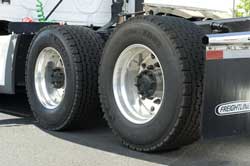 New generation wide-base singles continue to gain popularity, as well as drive and trailer wheel positions in the industry. More and more fleets and owner-operators are seeing the benefits this new wave of technology provides, and the number of tire manufacturers now producing and delivering wide-base singles to the trucking market has increased dramatically over the past 12 years.
New generation wide-base singles continue to gain popularity, as well as drive and trailer wheel positions in the industry. More and more fleets and owner-operators are seeing the benefits this new wave of technology provides, and the number of tire manufacturers now producing and delivering wide-base singles to the trucking market has increased dramatically over the past 12 years.
To gain an understanding of wide-base singles technology and how it could help save you money, here are some basics to consider and information on how to choose the best wide-base singles for your application.
- Fuel Savings: This is where rolling resistance comes in. Online resources allow you to compare the rolling resistance of competitive tires. The fuel savings advantage of wide-base singles stems from the basic fact that they reduce the number of tires on a truck. Energy is required to return each sidewall to its “upright” position, and the only place energy comes from on a truck is the fuel tank. That’s part of keeping the tire rolling down the road. With wide-base singles, the number of flexing sidewalls is decreased, lowering overall rolling resistance and increasing fuel economy. In comparison to fuel-efficient dual tires, some wide-base singles provide a fuel efficiency improvement of several percentage points.
A report made available by the Department of Energy’s Oak Ridge National Laboratory in 2009 found significant fuel efficiency improvement over dual tires when wide-base singles were in use – 6 percent overall and 10 percent with fully loaded tractor trailers. That’s $4,000 to $7,000 in fuel savings, based on a vehicle running 120,000 miles annually, getting 6.5 mpg and paying $4.00 a gallon for fuel.
- Weight Savings: In addition to the fuel savings, trucks using wide-base singles experience overall weight savings as well. Trucks with wide-base singles can save approximately 700 pounds per truck, allowing you to carry more payload, adding to your bottom line. Online calculators can help determine how much weight you would save in making the switch.
- Retreading: Wide-base singles are retreadable, allowing you to lower your overall cost of operation. Depending on the retread provider, there may be multiple wide-base single retread options available. High-quality wide-base single casings are able to be retreaded several times, so the original casing’s quality should factor into your decision when selecting the right wide-base singles for your truck.
- Ease of Maintenance: Ten is less than 18. This advantage is fairly obvious, but it has a few helpful implications. One up-front consequence is fewer tires to mount, dismount, inspect or rotate, resulting in less maintenance and downtime. Another factor is the ease of air pressure maintenance and pre-trip inspections. The majority of rapid air loss situations stem from poor pressure maintenance on the inside dual tire—a problem eliminated when switching to wide-base singles. You can eliminate the need to check that pesky inside dual tire.
- Used Trucks: With more and more fleets utilizing wide-base singles for fuel and weight savings, the used truck market is seeing an increased number of trucks with wide–base singles. This presents an advantage to used truck purchasers as they acquire the new technology of wide-base singles without the conversion cost of retrofitting. Used truck dealers can often convert a used truck currently on dual tires to wide-base singles and work the conversion cost into the truck loan. Certain wide-based singles are listed as a value-added option by The Truck Blue Book, adding more financial value to a used truck.
- Availability: Currently, seven tire manufacturers produce wide-base singles for the North American market. Wide-base singles are available at locations across the U.S., Canada, and Mexico, including most truck tire dealerships and truck stops. Numerous roadside breakdown services also offer wide–base singles and the response times for those calls are comparable to dual tires.
- Application: Not everyone operates in a long-haul application, so it’s important to find a wide-base single that meets the needs of your application. Ask for a wide-base single that can deliver the fuel efficiency, traction, and tread features you need—whether you operate on-highway, off-highway or even in a regional or urban application. Michelin, for example, offers six different wide-base singles, as well as six different retread options to serve various applications.
- Government Regulations: If you operate in California, you are no doubt aware of the California Air Resources Board (CARB) regulations in place requiring tractors running 53-foot trailers to use fuel-efficient tires to operate in the state. As other states review similar legislation, it’s important to note that the U.S. EPA SmartWaySM verified technologies list includes a number of wide-base singles from several manufacturers that can help you save fuel and weight, increase ease of maintenance and meet CARB requirements.
Hopefully these insights have helped you understand more about what benefits wide-base single technology can provide. Through fuel, weight, and maintenance savings, wide-base singles can help lower the total cost of ownership, which puts more money in your pocket. If you need more information, please visit www.gowidesavegreen.com. If you’re a wide-base single user, share your thoughts and experience in the comments section below.